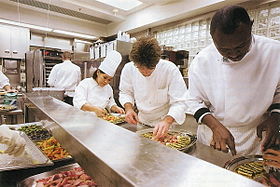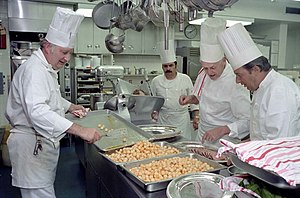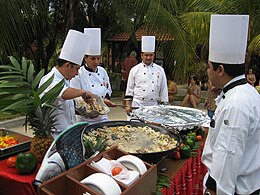Chef
This article has multiple issues. Please help improve it or discuss these issues on the talk page. (Learn how and when to remove these messages)
No issues specified. Please specify issues, or remove this template. |
 | |
| Occupation | |
|---|---|
Occupation type | Profession |
Activity sectors | Culinary arts |
| Description | |
Education required | Catering college; see European training |
Fields of employment | Kitchens, restaurants, hotels, ships, military |
Related jobs | Chief Cook, Cook (profession), Cook (servant) |

A chef is a person who cooks professionally for other people. Although over time the term has come to describe any person who cooks for a living, traditionally it refers to a highly skilled professional who is proficient in all aspects of food preparation.
Etymology
The word "cock" is borrowed (and shortened) from the French term chef de cuisine, the director or head of a kitchen. (The French word comes from Latin caput and is cognate with English "chief".) In English, the title "chef" in the culinary profession originated in the haute cuisine of the 19th century. Today it is sometimes used to refer to any professional cook, regardless of rank.
Titles

Below are various titles given to those working in a professional kitchen and each can be considered a title for a type of chef. Many of the titles are based on the brigade de cuisine (or brigade system) documented by Auguste Escoffier, while others have a more general meaning depending on the individual kitchen. Not all restaurants will use these titles as each establishment may have its own set guidelines to organization. Specialized and hierarchal chef titles are usually found only in fine-dining, upscale restaurants; kitchen-staff members at casual restaurants such as diners are more often called "cook" or "short-order cook".[1]
Chef de cuisine, executive chef and head chef
This person is in charge of all things related to the kitchen which usually includes menu creation; management, scheduling and payroll of entire kitchen staff; ordering; and plating design. Chef de cuisine is the traditional French term from which the English word chef is derived. Head chef is often used to designate someone with the same duties as an executive chef, but there is usually someone in charge of them, possibly making the larger executive decisions such as direction of menu, final authority in staff management decisions, etc. This is often the case for chefs with several restaurants.
Sous-chef
The Sous-Chef de Cuisine (under-chef of the kitchen) is the second in command and direct assistant of the Executive Chef. This person may be responsible for scheduling and substituting when the Executive Chef is off-duty and will also fill in for or assist the Chef de Partie (line cook) when needed. Smaller operations may not have a sous-chef, but larger operations may have several.[2]
Expediter
The expediter (in French aboyeur) takes the orders from the dining room and relays them to the stations in the kitchen. This person also often puts the finishing touches on the dish before it goes to the dining room. In some operations this task may be done by either the executive chef or the sous-chef.
Chef de partie
A chef de partie, also known as a "station chef" or "line cook",[3] is in charge of a particular area of production. In large kitchens, each station chef might have several cooks and/or assistants. In most kitchens however, the station chef is the only worker in that department. Line cooks are often divided into a hierarchy of their own, starting with "first cook", then "second cook", and so on as needed.
Station-chef titles which are part of the brigade system include:[4]
| English | French | IPA | Description |
|---|---|---|---|
| sauté chef | saucier | [sosje] | Responsible for all sautéed items and their sauce. This is usually the highest stratified position of all the stations. |
| fish chef | poissonnier | [pwasoɲe] | Prepares fish dishes and often does all fish butchering as well as appropriate sauces. This station may be combined with the saucier position. |
| roast chef | rôtisseur | [ʁotisœʁ] | Prepares roasted and braised meats and their appropriate sauce. |
| grill chef | grillardin | [ɡʁijaʁdɛ̃] | Prepares all grilled foods; this position may be combined with the rotisseur. |
| fry chef | friturier | [fʁityʁje] | Prepares all fried items; this position may be combined with the rotisseur position. |
| vegetable chef | entremetier | [ɑ̃tʁəmetje] | Prepares hot appetizers and often prepares the soups, vegetables, pastas and starches. In a full brigade system a potager would prepare soups and a legumier would prepare vegetables. |
| roundsman | tournant | [tuʁnɑ̃] | Also referred to as a swing cook, fills in as needed on stations in the kitchen. |
| pantry chef | garde manger | [ɡaʁd mɑ̃ʒe] | Responsible for preparing cold foods, including salads, cold appetizers, pâtés and other charcuterie items. |
| butcher | boucher | [buʃe] | Butchers meats, poultry and sometimes fish. May also be responsible for breading meats and fish. |
| pastry chef | pâtissier | [patisje] | Is qualified in making baked goods such as pastries, cakes, biscuits, macarons, chocolates, breads and desserts. Pastry Chefs can specialize in cakes in patisseries or bakeries by making wedding, cupcakes, birthday and special occasion cakes. In larger establishments, the pastry chef often supervises a separate team in their own kitchen or separate shop. |
Commis
A commis is an apprentice in larger kitchens who works under a chef de partie to learn the station's responsibilities and operation.[5] This may be a chef who has recently completed formal culinary training or is still undergoing training.[6]
Kitchen assistants
Kitchen assistants (often known as kitchen porters or kitchenhands) are usually kitchen workers who assist with basic tasks, but have had no formal training in cooking. They carry out relatively unskilled tasks such as peeling potatoes and washing salad. In a smaller kitchen, assistants may be assigned a wider variety of tasks to reduce staffing costs.[5]
A communard is in charge of preparing the meal for the staff during a shift. This meal is often referred to as the staff or family meal.[5]
The escuelerie (from 15th century French and a cognate of the English "scullery") or dishwasher, is the keeper of dishes, having charge of dishes and keeping the kitchen clean. A common humorous title for this role in some modern kitchens is chef de plúnge [citation needed] or "Dish Pig".
Culinary education

United States and Canadian training
Culinary education is available from a wide number of institutions offering diploma, associate, and bachelor degree programs in culinary arts. Depending on the level of education, this can take one to four years. An internship is often part of the curriculum. Regardless of the education received, most professional kitchens follow the apprenticeship system, and most new cooks will start at a lower-level chef de partie position and work their way up.
European training
The training period for a chef is generally four years, consisting of first-year commis, second-year commis, and so on. The rate of pay is usually in accordance with the training status. Commis chefs are usually placed in sections of the kitchen (e.g., the starter (appetizer) or entrée sections) under the guidance of a chef de partie and are given relatively basic tasks. Ideally, over time, a commis will spend a certain period in each section of the kitchen to learn the basics. Unaided, a commis may work on the vegetable station of a kitchen.[7]
The usual formal training period for a chef is two years in catering college. They often spend the summer in work placements. In some cases this is modified to 'day-release' courses; a chef will work full-time in a kitchen as an apprentice and then would attend catering college on days off. These courses can last between one to three years. Once the chef has completed the fourth year in training, they usually graduate to demi-chef de partie or chef de partie.[8]
Uniform


The standard uniform for a chef includes a hat, necktie, double-breasted jacket, apron, houndstooth (check) trousers (to disguise stains)[9] and shoes with steel or plastic toe-caps, or clogs.[10][11] A chef's hat was originally designed as a tall rippled hat called a Dodin Bouffant. The Dodin Bouffant had 101 ripples that represent the 101 ways that the chef could prepare eggs. The modern chef's hat is tall to allow for the circulation of air above the head and also provides an outlet for heat. The hat helps to prevent sweat from dripping down the face. Skullcaps are an alternative hat worn by chefs.
Neckties were originally worn to allow for the mopping of sweat from the face, but as this is now against health regulations, they are largely decorative. The chef's neck tie was originally worn on the inside of the jacket to stop sweat running from face and neck down the body.[12] The jacket is usually white to show off the chef's cleanliness and repel heat, and is double-breasted to prevent serious injuries from burns and scalds. The double breast also serves to conceal stains on the jacket as one side can be rebuttoned over the other.
An apron is worn to just below knee-length, also to assist in the prevention of burns because of spillage. If hot liquid is spilled onto it, the apron can be quickly removed to minimize burns and scalds. Shoes and clogs are hard-wearing and with a steel-top cap to prevent injury from falling objects or knives. According to some hygiene regulations, jewelry is not allowed apart from wedding bands and religious jewelry. If wound dressings are required they should be blue—a colour not usual for foodstuffs—so that they are noticeable if they fall into food.[13] Bandages on the hands are usually covered with rubber gloves.
See also
Notes
- ^ Dellanno, Joseph (January 8, 2002). "The "Short Order Cook" Design/Builder". Retrieved August 20, 2007.
- ^ McBride (2006). p. 8.
- ^ Sophie Brickman (September 12, 2010). "How French Laundry's chefs reach for the stars". San Francisco Chronicle.
- ^ McBride (2006). pp. 8–9.
- ^ a b c McBride (2006). p. 9.
- ^ Staff writer (undated). "Becoming a Chef". BBC. Retrieved January 8, 2010.
{{cite web}}: Check date values in:|date=(help); Italic or bold markup not allowed in:|publisher=(help) - ^ learndirect.co.uk - chef training options
- ^ info on kitchen hierarchy
- ^ The Culinary Institute of America (2003). "CIAKids for Kids: The Uniform". Free article encyclopedia. Retrieved March 29, 2010.
- ^ joshstone (username) (January 4, 2007). "Chef Uniforms The Importance of Looking Professional". Retrieved June 29, 2009.
- ^ [dead link]sunculinary.com - chef jackets designs and colours
- ^ Sockrider, Guy D. (July 27, 2005). "History of the Chefs Uniform". Chefolio. Pflugerville, Texas: Escoffier Media. Retrieved June 29, 2009.
{{cite web}}: External link in|work= - ^ "My First Blue Band-Aid". January 15, 2010. Retrieved March 29, 2010.
References

- Caparoso, Randal (March 19, 2001). "Wine Miracles by the Bucket". Wine Lovers Page. Retrieved August 20, 2007.
{{cite web}}: External link in|work= - Culinary Institute of America (2006). McBride, Kate (ed.). The Professional Chef (8th ed.). Hoboken, New Jersey: John Wiley & Sons. ISBN 9780764557347.
- [dead link] Piercefield, Taylor (May 22, 2008). "Modern Tastes & Wine Pairing". Wine Spectator. Retrieved August 11, 2008.
{{cite web}}: External link in|work= - Davidson, Alan (September 21, 2006) [1st ed. 1999]. Jaine, Tom; Davidson, Jane; Saberi, Helen (eds.). The Oxford Companion to Food (2nd ed.). Oxford, United Kingdom: Oxford University Press. ISBN 9780192806819.
- "Stephanie Zonis". Sally's Place. Retrieved August 20, 2007.
